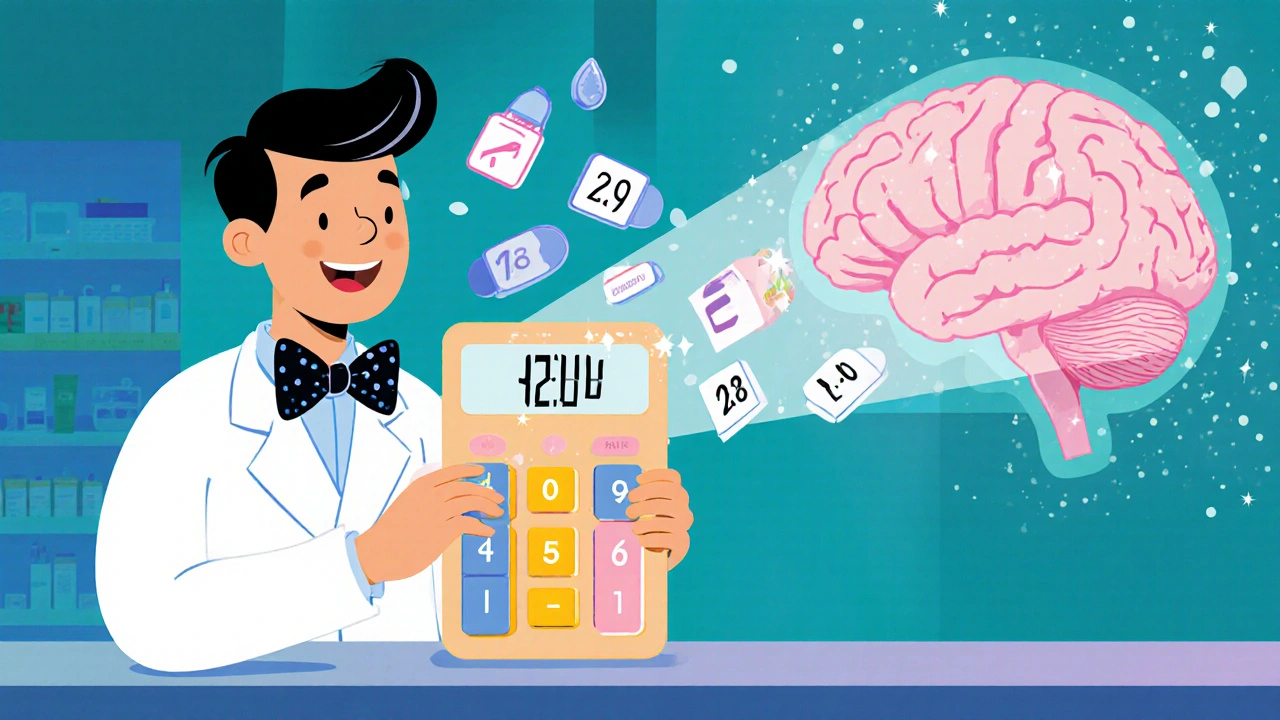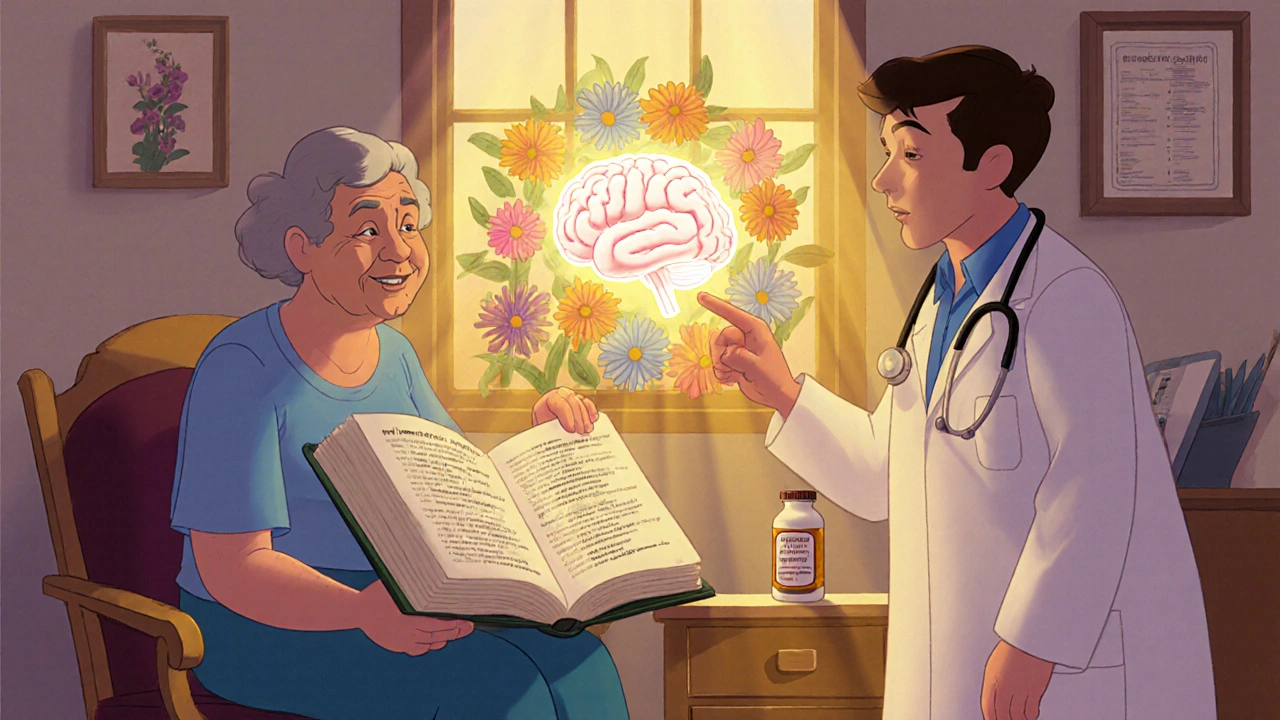Anticholinergic Burden Calculator
Calculate your anticholinergic burden score using the ACB (Anticholinergic Cognitive Burden) scale. This tool helps identify medications that may increase dementia risk.
Anticholinergic Burden (ACB) scores range from 0 to 3:
- Score 0: No anticholinergic activity
- Score 1: Possible anticholinergic activity
- Score 2: Likely anticholinergic activity
- Score 3: Definite anticholinergic activity
Research shows that when ACB score exceeds 1, dementia risk begins to increase significantly. Risk becomes statistically significant after about 90 cumulative defined daily doses, and climbs steeply beyond 1,095 doses.
When doctors prescribe drugs that block the brain chemical acetylcholine, they often think they’re just treating a symptom. Anticholinergic medications may feel harmless, but mounting evidence shows they can speed up cognitive decline and raise the odds of dementia. This article breaks down why the risk matters, how to measure it, which drugs are the biggest culprits, and practical steps you can take to protect brain health.
What are anticholinergic medications?
Anticholinergic Medications are a class of drugs that block the neurotransmitter acetylcholine in the central and peripheral nervous systems. They were first introduced in the mid‑20th century to treat conditions ranging from Parkinson’s disease to allergy symptoms and overactive bladder. Common examples include the antihistamine diphenhydramine (Benadryl), the bladder drug oxybutynin (Ditropan), and the tricyclic antidepressant amitriptyline (Elavil).
Why cognitive decline matters for people on these drugs
Researchers now view anticholinergic exposure as more than a temporary fog. Multiple cohort studies have linked long‑term use to lasting deficits in memory, executive function, and brain volume. For instance, a 2016 JAMA Neurology analysis found participants on medium‑ or high‑potency anticholinergics lost 0.5-1.2% more hippocampal volume each year than non‑users. That region is crucial for forming new memories.
Measuring anticholinergic burden
Clinicians use two standardized tools to gauge how much anticholinergic load a patient carries:
- Anticholinergic Cognitive Burden (ACB) scale assigns scores of 1 (possible) to 3 (definite) based on receptor affinity.
- Anticholinergic Risk Scale (ARS) adds points for dosage and duration, helping pharmacists flag high‑risk regimens.
Higher total scores correlate with poorer neuropsychological test results and an increased odds ratio (OR) for dementia ranging from 1.13 to 1.49, depending on the study.

Which drugs carry the highest dementia risk?
Not all anticholinergics affect the brain equally. Tertiary amines (e.g., doxepin) cross the blood‑brain barrier more readily than quaternary compounds (e.g., glycopyrrolate). Recent comparative work highlights specific classes:
| Drug Class | Typical Example | Adjusted OR (95% CI) |
|---|---|---|
| Anticholinergic Antidepressants (TCAs) | Amitriptyline | 1.29 (1.24-1.34) |
| Antipsychotics | Olanzapine | 1.20 (1.15-1.25) |
| Bladder Antimuscarinics | Oxybutynin | 1.23 (1.15-1.31) |
| Bladder Antimuscarinics | Solifenacin | 1.20 (1.12-1.28) |
| Bladder Antimuscarinics | Trospium | 1.03 (0.96-1.11) |
| Antiparkinson Drugs | Trihexyphenidyl | 1.10 (1.02-1.18) |
These numbers illustrate that tricyclic antidepressants and certain bladder agents are the most concerning, while quaternary agents like trospium appear safer.
Real‑world experiences: patients speak up
Online forums reveal a gap between clinical warnings and everyday awareness. One Reddit user reported her mother’s MMSE dropping from 28 to 22 after eight years of amitriptyline, with no full recovery after stopping the drug. In the Alzheimer’s Association community, several members described improved alertness after switching from oxybutynin to mirabegron, a non‑anticholinergic alternative.
Despite these anecdotes, many patients never hear the warning. A Drugs.com review of oxybutynin showed 68% of users praised bladder relief, while only 22% noted any cognitive side effects-suggesting under‑reporting.
Guidelines and tools for clinicians
Professional societies have begun to codify safer prescribing:
- The American Geriatrics Society’s Beers Criteria (2019) advises avoiding strong anticholinergics in adults over 65.
- Electronic health records now embed Anticholinergic Burden Calculators (e.g., the Finnish tool integrated into Epic) that flag high ACB scores at the point of order.
- Canadian Deprescribing Guidelines (2018) recommend a 4-8 week taper when stopping long‑term anticholinergics to prevent withdrawal.
Implementation studies show that training clinicians for 2-4 hours can cut inappropriate anticholinergic prescribing by up to 30%.

Deprescribing: how to reduce exposure safely
When you or a loved one are on an anticholinergic, consider these steps:
- Ask your prescriber to calculate your anticholinergic burden using ACB or ARS.
- Identify the highest‑scoring drugs (often amitriptyline, diphenhydramine, or oxybutynin).
- Discuss safer alternatives: SSRIs for depression, mirabegron for overactive bladder, or CBT for insomnia.
- If a drug must stay, aim for the lowest effective dose and limit duration.
- Schedule regular cognitive check‑ups (e.g., MMSE or MoCA) to track any changes.
Evidence suggests that cutting high‑burden drugs in middle age could prevent up to 10-15% of future dementia cases, translating to hundreds of thousands of avoidable diagnoses worldwide.
Key Takeaways
- Anticholinergic medications block acetylcholine and are linked to lasting cognitive decline.
- Long‑term exposure (over 1,095 defined daily doses) raises dementia risk by about 49%.
- Tricyclic antidepressants and certain bladder antimuscarinics carry the highest odds ratios.
- Tools like the ACB scale and Beers Criteria help clinicians spot high‑risk prescriptions.
- Deprescribing through safer substitutes and gradual tapering can lower brain‑age acceleration.
Frequently Asked Questions
How long does it take for cognitive effects to appear after starting an anticholinergic?
Short‑term use (a few weeks) may cause mild confusion, but most studies show measurable memory loss after six months of continuous use, and the risk climbs sharply after three years.
Can over‑the‑counter antihistamines like diphenhydramine increase dementia risk?
Yes. Diphenhydramine has an ACB score of 3 and accounts for roughly 45% of total anticholinergic exposure in community‑dwelling seniors.
Is there a safe threshold of anticholinergic exposure?
Research points to a dose‑response curve. Risk becomes statistically significant after about 90 cumulative defined daily doses, and climbs steeply beyond 1,095 doses.
What alternatives exist for overactive bladder without anticholinergic activity?
Mirabegron (a β‑3 agonist) has an ACB score of 0 and has shown comparable symptom control in large Phase III trials.
Should I stop my anticholinergic medication immediately if I’m worried about dementia?
Never stop abruptly without medical guidance. Sudden discontinuation can cause withdrawal, urinary retention, or rebound depression. A gradual taper, overseen by a clinician, is the safest route.
Do all older adults need cognitive screening when on anticholinergics?
Best practice is annual screening for anyone over 65 on any drug with an ACB score ≥2, especially if they have other dementia risk factors like hypertension or diabetes.
How reliable are the studies linking anticholinergics to dementia?
Most evidence comes from large observational cohorts with robust adjustments for confounders, but causality can’t be proven definitively. Ongoing randomized trials (e.g., the PREPARE trial) aim to settle the question.


krishna chegireddy
October 24, 2025
The elite circles of medicine love to cloak their agenda behind dry statistics. They whisper that anticholinergic drugs are harmless, yet the data screams otherwise. Every time a senior citizen is handed a pill that blocks acetylcholine, a piece of their memory is silently erased. It is not a coincidence that pharmaceutical giants profit from these prescriptions while the public bears the cognitive cost. The truth is hidden, and only the vigilant can uncover it.
Melanie Vargas
November 13, 2025
Hey everyone! 😊 It's so important to look out for each other when dealing with meds like these. If you or a loved one are on an anticholinergic, consider talking to your doctor about alternatives. Small changes can make a big difference for brain health! 🌟
Deborah Galloway
December 2, 2025
I'd like to add that I've seen friends feel a lot more clear‑headed after switching away from diphenhydramine. It can be scary to change a medication, but a gentle taper with a doctor's help often works well. Keep an eye on any mood or memory changes and let your healthcare team know right away. You're not alone in this, and many resources are out there to support you.
Charlie Stillwell
December 22, 2025
Alright, let’s cut the fluff. These anticholinergics are basically cognitive silencers wrapped in a pharmaceutical blanket. The ACB scale isn’t just a bureaucratic fad; it’s a jargon‑laden reality check. ⚡️ Stop playing with your brain like it’s a lab rat. If you’re not ready to drop the meds, at least demand a dose reduction. 🙄